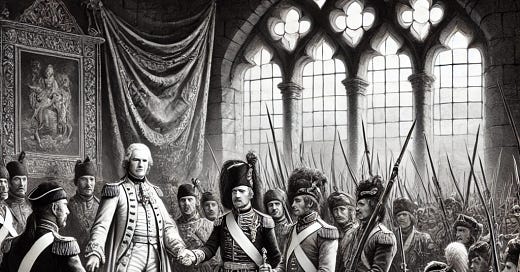General Wade and the Disarming of the Highland Clans
The early 18th century was a tumultuous time for the Scottish Highlands, marked by clan rivalries, Jacobite uprisings, and a persistent tension between Highland culture and the British government. Amidst this backdrop, General George Wade's efforts to disarm the Highland clans stand out as a significant turning point in the history of Scotland. His actions were part of a broader strategy to pacify the region and integrate it more firmly into the British state, and they had far-reaching consequences for the Highland way of life.
The Jacobite Threat
The early 1700s saw Scotland embroiled in the Jacobite uprisings, a series of rebellions aimed at restoring the Stuart monarchy. The Highlands were a stronghold of Jacobite support, with many clans rallying to the cause of "Bonnie Prince Charlie" and his predecessors. The failure of the 1715 uprising, led by the Earl of Mar, underscored the persistent threat the Highland clans posed to the British government. In response, measures were taken to weaken the military capabilities of these clans and reduce the likelihood of future insurrections.
The Disarming Act of 1716
In the aftermath of the 1715 uprising, the British government passed the Disarming Act of 1716. This legislation aimed to strip the Highland clans of their weapons, which were seen as essential to their ability to rebel. However, the act was met with limited success. The rugged terrain of the Highlands, coupled with the fierce independence of the clans, made enforcement difficult. Many clans hid their weapons or found ways to evade the law.
General Wade’s Mission
Recognizing the need for a more effective approach, the government appointed General George Wade to oversee the pacification of the Highlands. Wade was an experienced military leader known for his strategic acumen. His mission was not only to enforce the disarming of the clans but also to improve infrastructure and facilitate greater control over the region.
Wade’s plan included the construction of roads and bridges to improve access to the remote Highland areas. These roads, which came to be known as "Wade’s Roads," played a crucial role in enabling government forces to move more easily throughout the Highlands, thereby strengthening their ability to enforce the disarmament and maintain order.
The Disarming Campaign
Wade’s efforts to disarm the Highland clans began in earnest in 1725. He faced significant resistance, as many clans were deeply attached to their traditional weapons, which were symbols of their heritage and independence. The Mackenzie clan, one of the most powerful in the Highlands, exemplified this resistance. Under the leadership of Donald Murchison, a loyal servant of the exiled Earl of Seaforth, the Mackenzies managed to evade disarmament for a considerable period.
Murchison, who had previously fought for the Jacobites, took on the role of protecting the clan’s interests. He collected rents and managed the clan’s estates while their chief was in exile, ensuring that the British authorities could not seize the properties. When government troops attempted to enforce the disarming, Murchison and his followers successfully resisted, maintaining their weapons and their autonomy.
The Symbolic Surrender at Brahan Castle
Despite the resistance, General Wade’s persistence eventually led to a symbolic act of submission. On August 25, 1725, a significant event took place at Brahan Castle, the seat of the Mackenzie clan. Wade, accompanied by a small contingent of dragoons, witnessed a formal surrender of arms by the Mackenzies. However, this surrender was more symbolic than substantive. The clan turned over old and unusable weapons, while their more valuable arms were secretly retained and hidden by Murchison.
This act of partial compliance allowed Wade to claim a victory, while the Mackenzies retained their ability to defend themselves if needed. It was a delicate balancing act that reflected the complexities of Highland society and the challenges faced by the British government in enforcing its laws.
The Legacy of General Wade
General Wade’s efforts had a lasting impact on the Highlands. His road-building projects facilitated greater integration of the region into the British state and helped to curtail the power of the clans. The disarmament campaign, although not entirely successful in its immediate goals, signaled the beginning of the end for the traditional clan system. Over time, the combined effects of disarmament, economic change, and further government policies led to the decline of the clan structure and the assimilation of the Highlands into a more modernized Scotland.
Wade’s legacy is a complex one. On one hand, his actions helped to bring stability to a region long plagued by conflict. On the other hand, they contributed to the erosion of a unique cultural heritage that had defined the Highlands for centuries. The roads he built are still in use today, a testament to his engineering prowess and the lasting influence of his tenure.
Conclusion
General Wade’s campaign to disarm the Highland clans was a pivotal moment in Scottish history. It marked a concerted effort by the British government to bring the Highlands under control and to suppress the Jacobite threat. While the immediate results were mixed, the long-term effects were profound, leading to significant changes in Highland society and the gradual decline of the clan system. Wade’s legacy, encapsulated in the roads he built and the policies he enforced, continues to shape the Highlands to this day, serving as a reminder of a transformative period in Scotland’s past.





